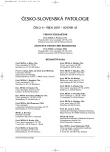Histopathologic Changes in Gastroesophageal Reflux Disease. A Study of 126 Bioptic and Autoptic Cases
Histopatologické změny u gastroezofageální refluxní nemoci. Studie souboru 126 bioptických a autoptických případů
Histologickou diagnózu refluxní ezofagitidy (RE) komplikuje nejednotný názor na typy sliznic v oblasti gastroezofageální junkce (GEJ). V současné době převládá názor, že v oblasti GEJ přechází dlaždicový epitel jícnu do žlazové sliznice kardie žaludku. Sliznice kardie je tvořena hlenovými nebo smíšenými hlenovými/oxyntickými žlázkami, které jsou neodlišitelné od metaplastické sliznice, vznikající v distálním jícnu při gastroezofageálním refluxu (GER). Ve žlazové sliznici se pravidelně nacházejí chronické zánětlivé změny označované jako „carditis“. Jejich příčinou je GER a/nebo infekce Helicobacter pylori (Hp). V naší sestavě 120 biopsií z oblasti GEJ a distálního jícnu byla ve všech zachycena sliznice typu kardie (CM), v 15 případech současně s oxyntokardiální sliznicí. V obou typech sliznic byl chronický neaktivní zánět, který se po vyloučení infekce Hp všeobecně považuje za diagnostický pro RE. U dvou nemocných se symptomatologií GER byla na povrchu CM řídká kolonizace Hp. Nález jsme hodnotili jako RE se superponovanou infekcí Hp. V 17 případech byla v CM intestinální metaplazie (IM) převážně nekompletního typu bez dysplazie. Intestinální metaplastický epitel exprimoval ve žlázové zoně – podobně jako okolní žlazky – mucin MUC6, zatímco v povrchovém a foveolárním epitelu byl MUC6 negativní nebo vykazoval jen slabou ložiskovou pozitivitu. V povrchovém a foveolárním epitelu byl intestinální epitel naopak pozitivní v barvení MUC5AC. Imunohistochemické vyšetření prokázalo v CM, Barrettově jícnu a v antrální sliznici shodnou lokalizaci cytokeratinů CK7/CK20.
V resekovaném jícnu pro adenokarcinom byla v okolí nádoru CM s nekompletní IM. Pod sliznicí se nacházely submukózní žlazky jícnu a v okolí jejich ústí překrývaly žlazovou sliznici ostrůvky dlaždicového epitelu. Přítomnost submukózních žlazek svědčí pro žlázovou metaplazii sliznice v distálním jícnu. V nekroptických jícnech 5 dětí ve věku 7–10 let se spastickou kvadruplegií byla u všech v GEJ zánětlivě změněná CM v délce 0,5–3mm, pravděpodobně metaplastického původu.
Klíčová slova:
gastroezofageální junkce – refluxní ezofagitida – kardie žaludku – carditis – metaplazie sliznice jícnu – intestinální metaplazie
Authors:
A. Chlumská 1,2; L. Boudová 1; Z. Beneš 3; M. Zámečník 1,2
Authors‘ workplace:
Šikl’s Department of Pathology, Faculty Hospital, Charles University, Pilsen
Czech Republic
1; Laboratory of Surgical Pathology, Pilsen, Czech Republic
2; Department of Hepatogastroenterology, Thomayer Faculty Hospital, Charles Universitiy
Prague, Czech Republic
3
Published in:
Čes.-slov. Patol., 43, 2007, No. 4, p. 142-147
Category:
Original Article
Overview
The histologic diagnosis of reflux esophagitis is still complicated by the lack of a consensus opinion on what is the normal mucosa in the area of the gastroesophageal junction (GEJ). Most authors consider GEJ as the junction between the squamous and the cardiac epithelium. The cardiac mucosa is composed of mucinous or mixed mucinous-oxyntic glands. These glands are in fact indistinguishable from metaplastic mucosa that arises in the distal esophagus in consequence of gastroesophageal reflux (GER). The cardiac mucosa shows invariably chronic inflammatory changes referred to as “carditis”. The cause of “carditis” is GER and/or Helicobacter pylori (HP) infection.
In our series of 120 endoscopic biopsies of the GEJ and distal esophagus the cardia type mucosa (CM) was always present. In 15 cases, it was accompanied by oxyntocardiac mucosa. Both mucosa types showed chronic inflammation that is after exclusion of HP infection regarded as a strong diagnostic sign of the gastroesophageal reflux disease (GERD). In two cases with clinical symptoms of GERD, a few HP were found on the CM. Therefore we diagnosed them as GERD with secondary HP infection. In 17 cases, CM displayed intestinal metaplasia (IM) predominantly of incomplete type and no dysplasia. This IM expressed MUC6 in the glandular zone of the mucosa like it did in the neighboring glands, whereas in the surface and foveolar epithelium the MUC6 was negative or only slightly and focally positive. On the other hand, IM in the surface and foveolar epithelium was reactive for MUC5AC. The positivity and distribution of CK7 and CK20 was very similar in the Barrett’s mucosa, cardiac mucosa and antral mucosa.
In one specimen of esophagus resected for adenocarcinoma, CM with incomplete IM was found in the vicinity of the tumor. Squamous metaplastic epithelium was often seen near the orifices of submucosal esophageal glands in these areas, indicating the metaplastic nature of the glandular mucosa in the distal esophagus. In the GEJ of 5 autopsy cases of children with spastic quadriplegia (age range 7-10 years) CM in a short segment (0.5-3 mm in length), probably of metaplastic origin was identified, showing chronic inactive inflammation.
Key words:
gastroesophageal junction – gastroesophageal reflux disease – gastric cardia – carditis – metaplasia of the esophagus – intestinal metaplasia
Labels
Anatomical pathology Forensic medical examiner ToxicologyArticle was published in
Czecho-Slovak Pathology

2007 Issue 4
Most read in this issue
- Mesenchymal Tumors of the Ovary and Uterine Corpus. Selected Review
- Intratubular Germ Cell Neoplasia – Review Article
- Histopathologic Changes in Gastroesophageal Reflux Disease. A Study of 126 Bioptic and Autoptic Cases
- Paraganglioma of the Mesenterium: a Case Report
